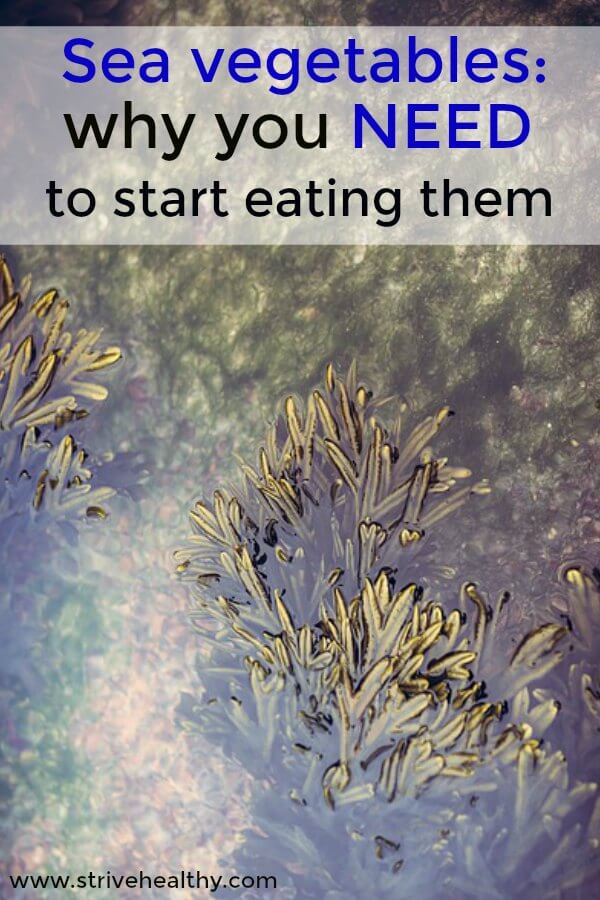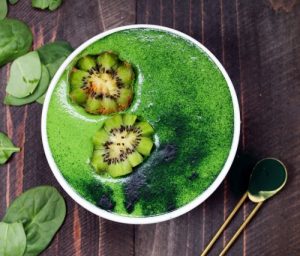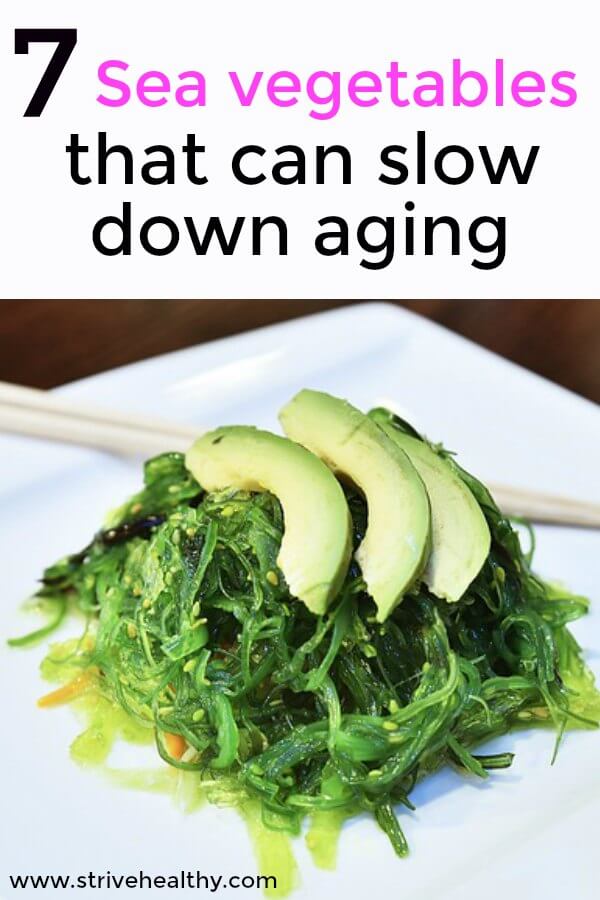When you think of filling your plate up with greens, do sea vegetables make the list?
You probably only consider plants from the earth but the sea is an amazing source of vegetables that have been eating for centuries in Asia.
Sea vegetables are a staple of many diets in countries like Japan, which also enjoy higher life expectancy rates and lower cancer rates than we do in the West.

This post contains affiliate links. I only promote products I recommend and trust. Please read my Disclosure for more information.
What’s A Sea Vegetable?
It sounds odd but sea vegetables are what we normally call seaweed and algae. Yes, that slightly slimy brown or green stuff is a mineral powerhouse! You have probably tried sushi that is wrapped in small pieces of seaweed but there are many varieties and ways to eat sea vegetables.
Health Benefits Of Sea Vegetables
Sea vegetables are great for your health because they are a source of minerals such as iodine, magnesium and iron while being low in fat, cholesterol and sugar. They are also plentiful and relatively inexpensive.
Sea vegetables are thought to be a fantastic anti-aging food source that is low calorie and tasty as they are naturally salty.
7 Sea Vegetables That Have Amazing Health Benefits
The list of sea vegetables below will show you the best sea vegetables you can try to promote your health. They are the most popular sea vegetables that are easily found in Western stores and online.
1. Arame
Arame is a type of brown algae used in Japanese cooking. It is most commonly found dried and is available year-round.
It has a fairly mild flavor, which makes it easy to add it to a wide variety of recipes and dishes.
Arame is rich in iron, magnesium, calcium, iodine and vitamin A. As well as being amazing for your nails, skin and hair, it is also popular as a natural detoxifier. Chlorophyll helps this incredibly healthy sea vegetable flush dangerous toxins from your body.
Arame makes a good side dish with meat or fish and can be added to soups or salads.
2. Dulse
Dulse is a red algae that grows along the northern coasts of the Pacific and Atlantic oceans. It has a smoky, spicy taste and can be used as a flavor enhancer as well as a stand-alone snack food. You may even want to put a few strips of it on your favorite sandwich to boost the nutritional content.
You can also brew dulse to make a tea.
Dulse provides a wealth of minerals, vitamins, fibre and protein. It is high in iodine and trace minerals and contains ten amino acids. Dulse is an excellent source of calcium, potassium, magnesium, iron, iodine, manganese, copper, chromium, zinc, and vitamins A, B1, B2, B3, B6, B12, C and E.
3. Wakame
This edible seaweed has a mild sweet flavor, which makes it great in many dishes including soups and salads.
As a brown algae, Wakame is rich in a substance called fucoxanthin. This ingredient has been shown to be successful at promoting weight loss.
Wakame is a good source of the minerals magnesium, iodine, calcium and iron as well as vitamins A, B2, C, D and K.
4. Nori
Nori is probably the most well-known sea vegetable in the West. If you’ve ever bought sushi at a Japanese restaurant, chances are it came wrapped in nori. Being used as a wrap for sushi and other foods is its primary culinary use, and many find it to be delicious when it’s toasted.
Nori is a red algae form of edible seaweed. It’s loaded with B vitamins and contains unsaturated fatty acids as well as plenty of proteins, vitamins, minerals and trace minerals.
5. Kelp
Kelp is a brown algae that grows in shallow ocean waters. It is packed with vitamins and minerals. Kelp grows in what are referred to as “underwater forests.” There are about 30 different genus of this species of brown algae, and they have an impressive growth rate. They stretch from the sea floor and can reach up over 200 feet in their quest to reach the sunlight at the surface.
Kombu is a popular type of kelp that is a common part of the diet throughout East Asia. It is eaten in soups, stews, teas and as a healthy snack.
Sea vegetables have been used for thyroid problems for many years and Kelp is very high in iodine and especially good for thyroid health. Kelp is also thought to boost metabolism and promote weight loss.
6. Agar
Also known as agar-agar, this natural jelly-like substance obtained from algae has a sweet flavor, which makes it a wonderful sugar substitute for use in a myriad of delicious dessert recipes.
It’ also makes a good gelatin substitute for vegetarians.
Agar is a good source of iron and calcium and is very high in fiber. Perhaps the best thing about it, however, from a health standpoint is what it does not contain. It has no sugar or fat and practically no carbohydrates.
7. Spirulina

Spriulina is a type of blue-green algae that is often found in green shake powders and smoothies.
You may have also seen some growing in the wild as it’s frequently that green mass floating on the surface of ponds that you might dismiss as pond scum.
Its nutrient-dense makeup starts with the fact that it’s 70 percent protein by weight. This is combined with a high concentration of vitamins and minerals. The World Food Conference declared it one of the best foods for the future in 1974, and NASA incorporated it into the diet plans for their astronauts since it provided them a superior nutritional profile.
Most commonly available as a supplement in stores, the best way to add spirulina to your diet may be to simply make a spirulina powder supplement the basis of a green smoothie to give yourself an energy boost in the morning.
4 Ways To Incorporate Sea Vegetables Into Your Diet
It’s easy to add sea vegetables into your diet either by adding them into foods you already enjoy or by taking a supplement.
- Spirulina is fairly simple in that it can be taken in pill or powder form.
- Arame is a mild tasting form of kelp that can added to salad dressings and pasta sauces.
- Whenever you have miso soup, don’t forget to add some kombu to it to give it a nutritional boost.
- Dulse makes a tasty and nutritious addition to a sandwich, some say it can taste like bacon!
Where To Buy Sea Vegetables
You can buy sea vegetables in many supermarkets, ethnic food markets and health food stores. You can also buy sea vegetables at good prices online at sites such as Amazon.com.
Arame – You can buy dried arame easily although it can be a bit pricey.
Dulse – dulse typically comes in flakes that you can use on salads and other foods.
Wakame – Dried wakame is easy to buy in health food stores. You can also buy instant soup packages that contain wakame
Nori – Nori comes in flat sheets that you can use as sushi wraps or just eat as a snack.
Kelp- Buy kombu in flakes and powders that you can add to smoothies and drinks.
Agar – You can buy agar in powder form that can be made into a jelly.
Spirulina – This seaweed comes in many forms – you can buy tablets, tea and even pasta containing spirulina.
What To Read Next
10 Natural Health Gift Ideas Your Friends Will Love
8 ways to naturally ease sciatica in pregnancy
5 Yoga Stretches For Sciatic Nerve Pain







Leave a Reply